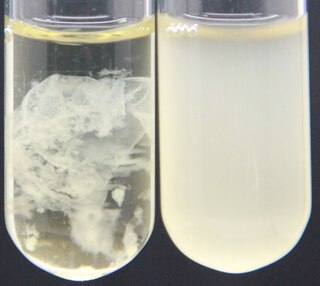
Pseudomonadota is a major phylum of Gram-negative bacteria. The renaming of several prokaryote phyla in 2021, including Pseudomonadota, remains controversial among microbiologists, many of whom continue to use the earlier name Proteobacteria, of long standing in the literature. The phylum Proteobacteria includes a wide variety of pathogenic genera, such as Escherichia, Salmonella, Vibrio, Yersinia, Legionella, and many others. Others are free-living (non-parasitic) and include many of the bacteria responsible for nitrogen fixation.

The Rhodospirillales are an order of Pseudomonadota.

The Nitrosomonadales are an order of the class Betaproteobacteria in the phylum "Pseudomonadota". Like all members of their class, they are Gram-negative.

The Rhizobiaceae is a family of Pseudomonadota comprising multiple subgroups that enhance and hinder plant development. Some bacteria found in the family are used for plant nutrition and collectively make up the rhizobia. Other bacteria such as Agrobacterium tumefaciens and Rhizobium rhizogenes severely alter the development of plants in their ability to induce crown galls or hairy roots, respectively. The family has been of an interest to scientists for centuries in their ability to associate with plants and modify plant development. The Rhizobiaceae are, like all Pseudomonadota, Gram-negative. They are aerobic, and the cells are usually rod-shaped. Many species of the Rhizobiaceae are diazotrophs which are able to fix nitrogen and are symbiotic with plant roots.

Caulobacteraceae is a family of Pseudomonadota within the alpha subgroup. Like all Pseudomonadota, the Caulobacteraceae are gram-negative. Caulobacteraceae includes the genera Asticcacaulis, Brevundimonas, Phenylobacterium and Caulobacter.

Caulobacterales is an order of gram-negative pseudomonadota within the alpha subgroup.

The Thiotrichales are an order of Pseudomonadota, including Thiomargarita magnifica, the largest known bacterium.

The Burkholderiales are an order of Pseudomonadota. Like all Pseudomonadota, they are Gram-negative. They include several pathogenic bacteria, including species of Burkholderia, Bordetella, and Ralstonia. They also include Oxalobacter and related genera, which are unusual in using oxalic acid as their source of carbon. Other well-studied genera include Alcaligenes, Cupriavidus, Achromobacter, Comamonas, Delftia, Massilia, Duganella, Janthinobacterium, Polynucleobacter, non-pathogenic Paraburkholderia, Caballeronia, Polaromonas, Thiomonas, Collimonas, Hydrogenophaga, Sphaerotilus, Variovorax, Acidovorax, Rubrivivax and Rhodoferax, and Herbaspirillum.

The Legionellales are an order of Pseudomonadota. Like all Pseudomonadota, they are Gram-negative. They comprise two families, typified by Legionella and Coxiella, both of which include notable pathogens. For example, Q fever is caused by Coxiella burnetii and Legionella pneumophila causes Legionnaires' disease and Pontiac fever.
The Rhodocyclaceae are a family of gram-negative bacteria. They are given their own order in the beta subgroup of Pseudomonadota, and include many genera previously assigned to the family Pseudomonadaceae.

The Rhodocyclales are an order of the class Betaproteobacteria in the phylum "Pseudomonadota". Following a major reclassification of the class in 2017, the previously monofamilial order was split into three families:

The Comamonadaceae are a family of the Betaproteobacteria. Like all Pseudomonadota, they are Gram-negative. They are aerobic and most of the species are motile via flagella. The cells are curved rod-shaped.

The Aeromonadales are an order of Pseudomonadota, with 10 genera in two families. The species are anaerobic. The cells are rod-shaped. Some species of this order are motile by a single polar flagellum; others are not motile.
Xanthomonadaceae is a family of Pseudomonadota within the Xanthomonadales order. It was previously known as Lysobacteraceae.

The Cardiobacteriaceae are a family of Pseudomonadota, given their own order. They are Gram-negative and rod-shaped, with diameters around 0.5 to 1.7 μm and lengths from 1–6 μm.

The Alteromonadales are an order of Pseudomonadota. Although they have been treated as a single family, the Alteromonadaceae, they were divided into eight by Ivanova et al. in 2004. The cells are straight or curved rods. They are motile by the use of a single flagellum. Most of the species are marine.

The Oxalobacteraceae are a family of bacteria, included in the order Burkholderiales. Like all Pseudomonadota, Oxalobacteraceae are Gram-negative. The family includes strict aerobes, strict anaerobes, and nitrogen-fixing (diazotrophic) members. The cells are curved, vibroid, or straight rod-shaped.
The Thiotrichaceae are a family of Pseudomonadota, including Thiomargarita namibiensis, the largest known bacterium. Some species are movable by gliding, Thiospira by using flagella.
Oceanospirillaceae is a family of Pseudomonadota. Most genera in this family live in environments with high concentrations of salt; they are halotolerant or halophilic. They are marine, except Balneatrix which is found in fresh water and Venatorbacter, which is from terrestrial origin.All members are strictly aerobic, except Neptunomonas which can perform fermentation reactions.

Comamonas is a genus of bacteria in the phylum Pseudomonadota. Like all Pseudomonadota, they are Gram-negative bacteria. Comamonas species are aerobic organisms and motile using bipolar or polar tufts of one to five flagella. Comamonas testosteroni and Comamonas kerstersii have been found to cause infections in people.














